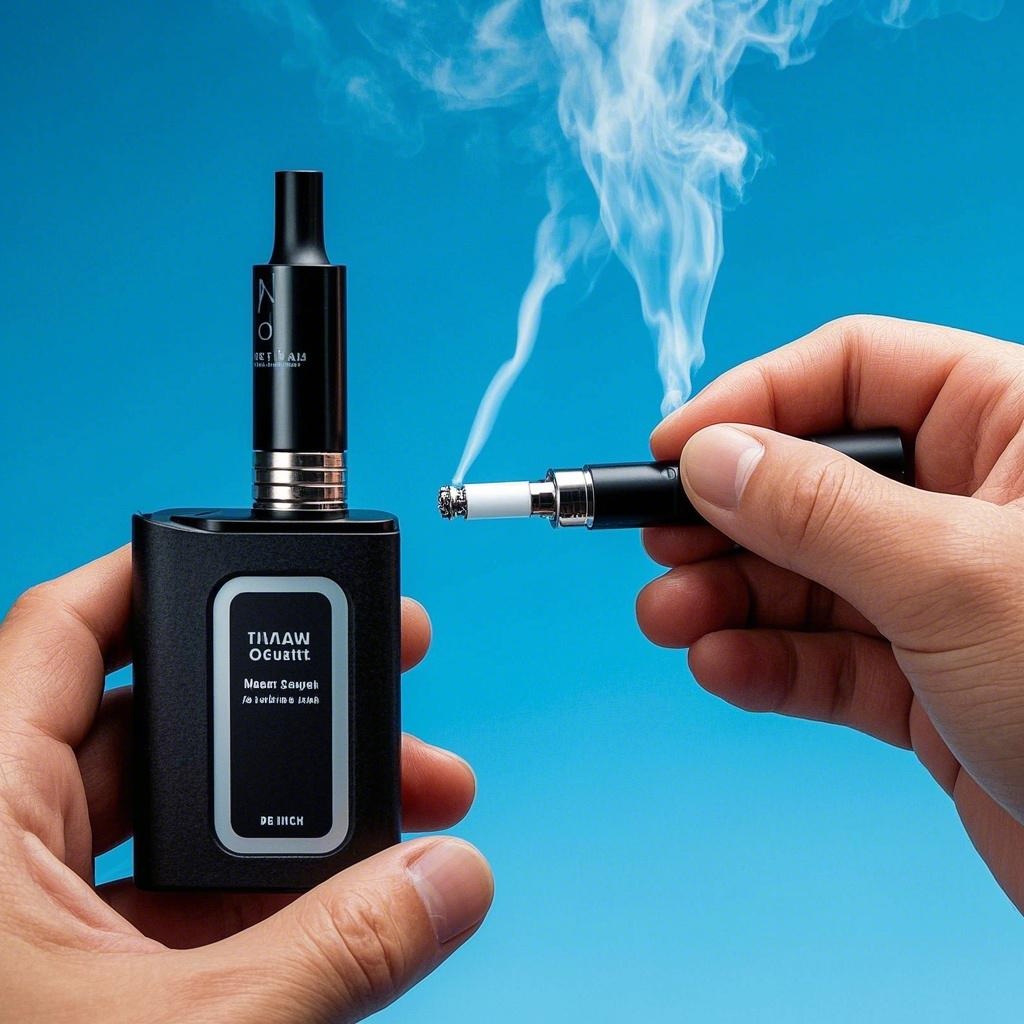In recent years, e-cigarettes have gained popularity as a seemingly safer alternative to traditional smoking. But how true is this claim? With a growing number of people turning to e-cigarettes in an attempt to quit smoking, many are left wondering whether vaping is actually a healthier option. In this article, we’ll dive into the key differences between e-cigarettes and traditional cigarettes, explore the potential health risks, and examine whether e-cigarettes are truly a safer choice. Whether you’re a current smoker considering a switch or just curious about the risks, this article will help you understand the facts behind the debate.
Key Differences Between E-Cigs and Cigarettes
How E-Cigs and Traditional Cigarettes Work
When comparing e-cigarettes and traditional cigarettes, the most significant difference lies in their methods of delivering nicotine and other substances to the body.
- E-Cigarettes: These devices work by heating a liquid (often referred to as “e-liquid” or “vape juice”) that contains nicotine, flavorings, and other chemicals to create a vapor, which is then inhaled. The e-liquid does not burn but is vaporized by the battery-powered heating element inside the device.
- Traditional Cigarettes: Cigarettes, on the other hand, contain tobacco that is burned when lit. The combustion process releases a large number of harmful chemicals, including tar, carbon monoxide, and carcinogens, which are known to cause serious health issues.
Comparison Table: E-Cigs vs. Traditional Cigarettes
| Feature | E-Cigarettes | Traditional Cigarettes |
|---|---|---|
| Nicotine Delivery | Vaporized liquid with nicotine | Smoke from burning tobacco |
| Method of Consumption | Inhalation of vapor | Inhalation of smoke |
| Chemicals Released | Fewer harmful chemicals (but not zero) | Hundreds of harmful chemicals, including tar and carbon monoxide |
| Health Risks | Potentially lower risk, but still under study | High risk of lung cancer, heart disease, and respiratory issues |
| Additives | Flavored e-liquids, generally safer | Additives like ammonia, tobacco-specific nitrosamines, etc. |
How These Differences Impact Health Risks
The key distinction is that e-cigarettes do not burn tobacco, which reduces the number of toxic byproducts created. However, while vaping is generally considered less harmful than smoking, it’s not without risks. E-cigarettes still deliver nicotine, which is addictive and can have adverse effects on the cardiovascular system.
In contrast, traditional cigarettes expose users to a range of dangerous chemicals that can lead to severe health conditions such as lung cancer, emphysema, and heart disease. The combustion process in cigarettes creates numerous carcinogens and toxins, which are responsible for most of the health risks associated with smoking.
By understanding these differences, we can better evaluate the potential health risks of switching from traditional cigarettes to e-cigarettes. While e-cigs may be a less harmful option, they are not without their own concerns.
Does E-Cigarettes Contain Harmful Substances?
What’s Inside E-Cigarette Liquids?
E-cigarette liquids, also known as e-juices, can contain several ingredients, some of which may raise health concerns. The most common ingredients in e-liquid include:
- Nicotine: A highly addictive substance that can increase heart rate and blood pressure, and may contribute to cardiovascular issues.
- Propylene Glycol (PG): A common carrier liquid that helps produce vapor. While generally recognized as safe in food and pharmaceuticals, inhaling PG may irritate the throat and lungs.
- Vegetable Glycerin (VG): A thicker liquid that produces vapor. VG is considered safe for consumption but can cause respiratory irritation when inhaled in large amounts.
- Flavorings: Various artificial and natural flavors are added to make the vaping experience more enjoyable. Some flavoring chemicals, such as diacetyl, have been linked to respiratory issues like “popcorn lung” when inhaled in high doses.
Potential Harmful Chemicals in E-Cigarette Vapor
While e-cigarette vapor contains fewer toxic substances compared to cigarette smoke, it is not entirely free of harmful chemicals. Studies have shown that when e-liquids are heated, certain chemicals can break down into potentially harmful byproducts.
- Formaldehyde: A carcinogen that can be produced when e-liquids are heated at high temperatures. While the levels are much lower than those in traditional cigarette smoke, exposure to formaldehyde can still be harmful.
- Acetaldehyde: Another toxic compound that can form when e-liquids are heated. It’s known to irritate the eyes, skin, and respiratory system.
- Acrolein: A harmful substance that can cause lung damage and is produced when e-liquids are heated at high temperatures.
Comparison Table: Harmful Substances in E-Cigs vs. Cigarettes
| Substance | E-Cigarettes | Traditional Cigarettes |
|---|---|---|
| Nicotine | Present, addictive | Present, highly addictive |
| Formaldehyde | Small amounts at high temperatures | Present in significant amounts due to combustion |
| Acetaldehyde | Small amounts | Present in significant amounts |
| Acrolein | Produced in small amounts at high heat | Present in significant amounts |
| Toxic Chemicals | Lower levels than cigarettes | High levels, including tar and carbon monoxide |
Health Implications of Harmful Substances
Although e-cigarettes generally contain fewer harmful substances than traditional cigarettes, they are not without risks. The inhalation of chemicals such as formaldehyde and acetaldehyde can still lead to respiratory irritation and long-term lung damage, especially if used frequently or over extended periods. Additionally, while nicotine is the main addictive substance, it can also increase the risk of cardiovascular problems when consumed in large quantities.
Therefore, while e-cigarettes may be a less harmful alternative to smoking, they still pose health risks, and users should be mindful of the substances they are inhaling.
Long-Term Health Effects of E-Cigarettes
What Does Current Research Say About Long-Term Risks?
While e-cigarettes are often marketed as a less harmful alternative to smoking, their long-term health effects remain uncertain. Because e-cigarettes have only been widely available for a relatively short period, there is limited data on the full range of health consequences that could arise from prolonged use. However, several studies have started to shed light on potential risks.
- Cardiovascular Health: Some research suggests that e-cigarettes may negatively affect cardiovascular health. Nicotine, present in most e-liquids, can increase heart rate and blood pressure, which over time could elevate the risk of heart disease. While e-cigarettes expose users to fewer toxins than traditional cigarettes, studies have shown that vaping still has an impact on blood vessel function and can contribute to the development of cardiovascular issues.
- Lung Health: Long-term vaping may cause respiratory problems. Chemicals in e-cigarette vapor, such as propylene glycol and vegetable glycerin, can irritate the airways and contribute to conditions like chronic bronchitis. Furthermore, inhaling vaporized substances can affect lung tissue and lead to reduced lung function over time.
- Cancer Risks: Although e-cigarettes do not contain the same carcinogens as traditional cigarettes, some studies suggest that prolonged exposure to certain chemicals in e-cigarette vapor, such as formaldehyde and acetaldehyde, could increase the risk of cancer. However, more research is needed to understand the full extent of this risk.
Comparison Table: Long-Term Health Risks of E-Cigarettes vs. Cigarettes
| Health Risk | E-Cigarettes | Traditional Cigarettes |
|---|---|---|
| Cardiovascular Disease | Potential risk due to nicotine | High risk from nicotine and other toxins |
| Lung Diseases | Possible lung irritation and reduced function | High risk of chronic obstructive pulmonary disease (COPD), emphysema, lung cancer |
| Cancer | Increased risk from certain chemicals (e.g., formaldehyde) | High risk due to carcinogens in smoke, including tar and nicotine |
| Respiratory Irritation | Possible due to PG and VG inhalation | Significant due to tar and other combustion byproducts |
Potential Long-Term Effects Based on Existing Studies
- Heart Disease: Some studies suggest that long-term vaping may contribute to heart disease, although the risk is likely lower than smoking cigarettes. Nicotine and other chemicals in e-cigarettes may still affect heart health in the long run.
- Lung Disease: While the risks of lung diseases like emphysema and chronic obstructive pulmonary disease (COPD) are significantly lower with e-cigarettes than with cigarettes, chronic exposure to vaporized chemicals can still lead to lung issues over time.
- Cancer: Although e-cigarettes are generally considered to have a lower cancer risk than traditional cigarettes, some researchers have raised concerns about the potential carcinogenic effects of substances like formaldehyde and acetaldehyde, which may be released during the heating process.
In conclusion, while e-cigarettes may be a safer alternative to smoking in the short term, the long-term health effects are still not fully understood. As more research is conducted, it will be important to weigh the potential risks of vaping against the known dangers of smoking.
E-Cigarettes and Their Effectiveness in Helping Smokers Quit
How E-Cigarettes Can Help Smokers Quit
E-cigarettes have been marketed as a tool to help smokers transition away from traditional cigarettes. Many smokers turn to vaping in hopes of reducing their nicotine intake or quitting altogether. The primary appeal of e-cigarettes as a smoking cessation aid is that they provide a similar experience to smoking, but with fewer harmful chemicals.
- Nicotine Replacement: E-cigarettes can act as a form of nicotine replacement therapy (NRT), offering smokers a way to gradually reduce their nicotine dependence. With varying nicotine concentrations available in e-liquids, users can adjust their intake over time, potentially leading to lower addiction levels.
- Behavioral Similarities: Vaping mimics many of the behaviors associated with smoking, such as hand-to-mouth motion and inhalation of vapor. This can be helpful for smokers who find it difficult to break the psychological habits tied to smoking.
Research on E-Cigarettes as a Smoking Cessation Tool
Several studies have been conducted to examine whether e-cigarettes are effective in helping smokers quit. The results have been mixed, with some research supporting the idea that e-cigarettes can aid in smoking cessation, while other studies highlight their potential to maintain nicotine addiction.
- Positive Results: A 2021 study published in the New England Journal of Medicine found that e-cigarettes were more effective than traditional nicotine replacement therapies (such as nicotine patches) in helping smokers quit. The study showed that smokers who used e-cigarettes were more likely to stop smoking than those using other methods.
- Mixed Findings: However, other research indicates that while e-cigarettes may help some smokers quit, they may also attract non-smokers and young people to start vaping. Additionally, some smokers may continue using e-cigarettes long-term, which can perpetuate nicotine addiction.
Common Challenges in Smoking Cessation and the Role of E-Cigarettes
Quitting smoking is a difficult process, and many smokers face significant challenges during their attempts. Some of the most common hurdles include:
- Nicotine Withdrawal: Nicotine is highly addictive, and quitting smoking often leads to withdrawal symptoms such as irritability, anxiety, and difficulty concentrating. E-cigarettes may help reduce these symptoms by providing a controlled amount of nicotine.
- Psychological Dependence: Many smokers are not just physically addicted to nicotine but also psychologically reliant on the act of smoking. E-cigarettes offer a way to maintain the behavioral aspects of smoking, which can make the transition away from traditional cigarettes easier.
- Relapse: Even with the help of e-cigarettes, some smokers may relapse. The transition to e-cigarettes doesn’t always mean quitting nicotine entirely, and some smokers may continue to vape long-term or return to smoking traditional cigarettes.
Comparison Table: E-Cigarettes vs. Other Smoking Cessation Methods
| Method | Effectiveness in Quitting Smoking | Advantages | Disadvantages |
|---|---|---|---|
| E-Cigarettes | Mixed results, but can aid cessation | Similar smoking experience, gradual nicotine reduction | Potential to maintain nicotine addiction, not always effective |
| Nicotine Patches | Proven effectiveness | Consistent nicotine delivery, reduces withdrawal symptoms | Does not address behavioral aspects of smoking |
| Nicotine Gum | Effective for some smokers | Portable, helps control cravings | Some smokers may continue using long-term |
| Prescription Medications (e.g., varenicline) | High effectiveness in studies | Can significantly reduce cravings and withdrawal symptoms | May cause side effects like nausea or sleep disturbances |
Conclusion: Can E-Cigarettes Be a Healthier Alternative?
E-cigarettes may provide a useful alternative for smokers who are trying to quit, especially when compared to the harmful effects of traditional cigarettes. However, they are not without their own risks. While vaping may be less harmful than smoking, the ultimate goal should be to quit nicotine entirely. E-cigarettes can play a role in helping smokers reduce or eliminate their cigarette consumption, but they should be viewed as a tool to aid in the quitting process, not as a permanent solution.
E-Cigarettes Regulation and Safety
Current Regulatory Landscape for E-Cigarettes
The regulation of e-cigarettes varies widely from country to country, and the lack of uniform standards raises concerns about product quality and consumer safety. In many countries, e-cigarettes are still considered relatively new products, and the regulatory frameworks are evolving.
- United States: The Food and Drug Administration (FDA) has the authority to regulate e-cigarettes as tobacco products. In 2016, the FDA extended its regulatory authority to cover e-cigarettes, requiring manufacturers to submit their products for review. However, there are still many gaps in regulation, particularly concerning e-cigarette flavors and marketing practices aimed at younger audiences.
- European Union: The European Union has more stringent regulations in place. The Tobacco Products Directive (TPD) regulates e-cigarettes and related products, including limits on nicotine strength, packaging, and product safety standards. E-cigarettes must be approved for sale, and manufacturers must comply with safety and quality requirements.
- Other Countries: In some countries, such as Australia and India, e-cigarettes are banned entirely, while others have no clear regulations in place. The absence of clear regulatory guidelines makes it difficult for consumers to make informed decisions about product safety.
Quality Control and Safety Issues with E-Cigarettes
One of the biggest concerns regarding e-cigarettes is the lack of consistent product quality control. Since e-cigarettes are not uniformly regulated in many markets, consumers may encounter products that are poorly manufactured, contain harmful ingredients, or lack proper safety features.
- Manufacturing Standards: E-cigarette manufacturers often follow their own safety standards, but there are no universal guidelines for product design, production, and testing. This inconsistency can lead to variations in the quality and safety of e-cigarettes.
- Contaminants in E-Liquids: Studies have found that some e-liquids contain harmful contaminants, such as diacetyl (a chemical linked to lung disease), and other potentially harmful additives. The lack of strict regulations means that some e-liquids may contain higher levels of nicotine or other chemicals than advertised, posing health risks.
- Battery Safety: E-cigarettes rely on lithium-ion batteries, which can be hazardous if not manufactured or used correctly. There have been reports of batteries overheating, catching fire, or even exploding, which highlights the importance of proper battery safety and quality control.
How Consumers Can Ensure They Choose Safe E-Cigarette Products
Given the concerns over quality control and the regulatory gaps in many countries, it’s essential for consumers to be cautious when purchasing e-cigarettes. Here are some tips for choosing safe and reliable products:
- Look for Certifications: Choose products that are certified by recognized regulatory authorities. In the European Union, for example, e-cigarettes must meet specific safety standards, including packaging and labeling requirements.
- Check for Transparency: Reputable manufacturers should provide clear information about their products, including ingredients in e-liquids, nicotine levels, and safety features. Avoid products from brands that lack transparency or have unclear product specifications.
- Avoid Counterfeit Products: The lack of regulation has led to an influx of counterfeit e-cigarette products, which may not meet safety standards. Be sure to purchase from trusted retailers or directly from manufacturers who have a proven track record.
- Consider Independent Testing: Some manufacturers submit their products to independent third-party testing to verify the quality and safety of their products. Consumers should look for products with verifiable test results and certifications from third-party labs.
Comparison Table: E-Cigarette Regulation Around the World
| Region/Country | Regulation Status | Key Features of Regulation |
|---|---|---|
| United States | FDA regulates e-cigarettes as tobacco products | Requires product review and safety data submission; flavor regulations still evolving |
| European Union | Regulated under Tobacco Products Directive (TPD) | Limits on nicotine strength, safety standards for e-liquids, packaging requirements |
| Australia/India | Banned or restricted | E-cigarettes are prohibited in many areas |
| China | Limited regulation | No specific regulations for e-cigarettes, but products must comply with general safety standards |
| Other Countries | Varies | Some countries have no regulations, leading to inconsistent product safety |
Conclusion: The Need for Stronger E-Cigarette Regulations
While e-cigarettes may offer a safer alternative to smoking, their safety is largely dependent on regulation and quality control. Consumers should be vigilant about the products they purchase and choose brands that adhere to safety standards and offer transparency. Stronger regulations and standardized safety measures are essential to ensure that e-cigarettes remain a safer option for users and do not pose unnecessary health risks.
In conclusion, while e-cigarettes may present a less harmful alternative to traditional smoking, they are not without risks. The main differences between e-cigarettes and cigarettes lie in the method of nicotine delivery and the number of harmful chemicals produced. However, the potential for long-term health effects, such as cardiovascular and respiratory issues, remains a concern.
Although e-cigarettes can help some smokers quit, they also have their own challenges, particularly when it comes to addiction and long-term use. Moreover, the lack of comprehensive regulation in many countries makes it difficult for consumers to ensure they are purchasing safe, high-quality products.
Ultimately, while e-cigarettes might be a healthier option compared to cigarettes, they are not risk-free. Smokers should weigh the benefits and risks carefully and consider quitting nicotine entirely as the ultimate goal. As research and regulation continue to evolve, more clarity will emerge on the true safety of e-cigarettes. For now, being informed and making cautious choices is key to safeguarding your health.




